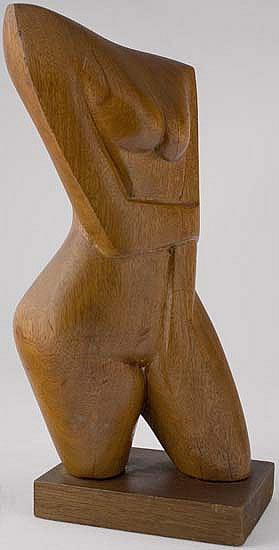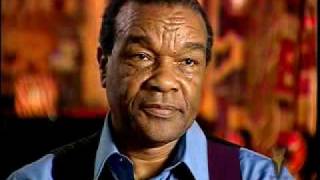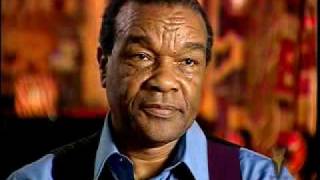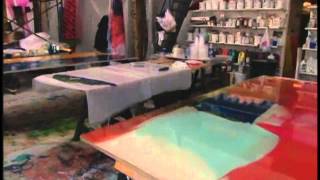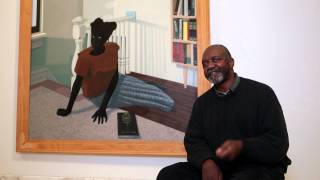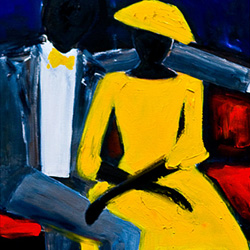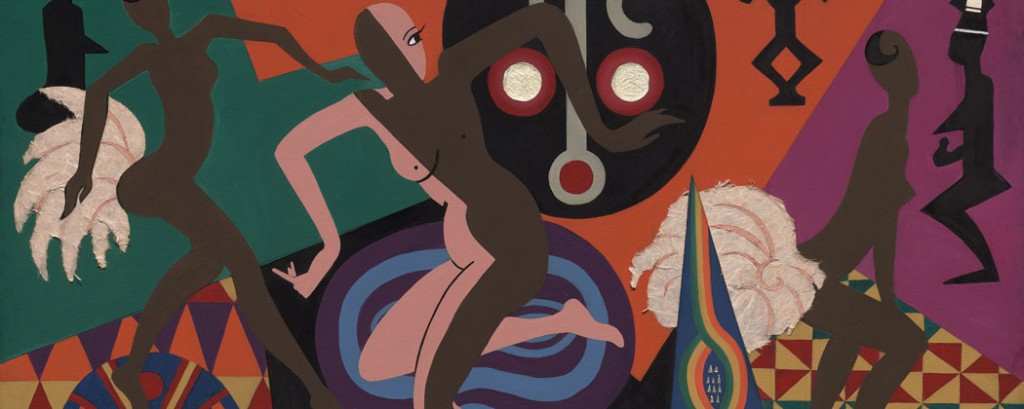
Artful Film, African American Art – October Gallery
Charles Bibbs – Visual Artist
Charles Bibbs
Contemporary Visual Artist
Entrepreneur and Philanthropist
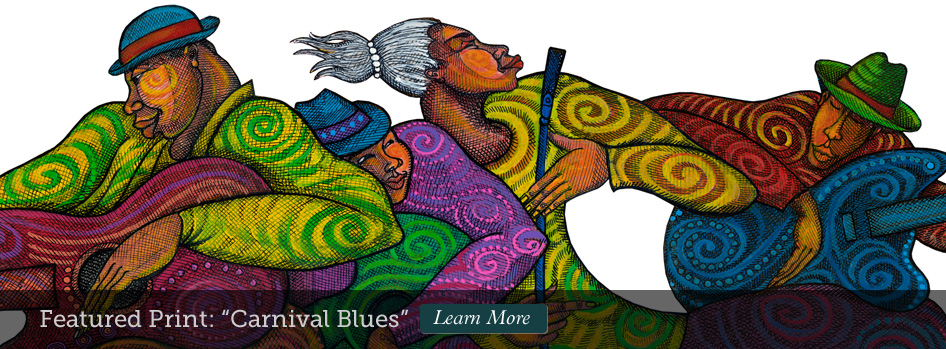
Internationally acclaimed artist Charles Bibbs, whose work is featured in museums, galleries, organizations, and homes of many collectors, displays a deep sense of Spirituality, Majesty, Dignity, Strength and Grace in his images, that is done in a combination of realistic and larger-than-life interpretations of contemporary subjects that are ethnically rooted.
Born in San Pedro, California, and raised in Harbor City, California, Bibbs managed to work an eight-hour job, and use his God-given talent in his spare time. But In 1991, Bibbs decided to leave his management position of 25 years, to form his own publishing and distribution company, B Graphics and Fine Arts, Inc. Today, Bibbs is one of the top-selling artists in the country, and his company has grown to be one of the leaders in the African American art print market.
Bibbs strongly believe that we are the “Keepers of our Culture,” and as such, have spent much of his time serving on boards of museums and art organizations to support the art community. He has lectured, and conducted panels and workshops in major cities, including the Charles Wright African American Museum in Detroit, Urban League of Pittsburg and the Riverside Metropolitan Museum. He has a sincere passion for supporting the youth, and as such, has mentored, taught and conducted numerous workshops for young aspiring artists.
In his quest to preserve and develop the visual arts, Bibbs founded Images Magazine, the first national publication dedicated to contemporary African American art, Art 2000 Visual Arts Association, Art on Tour, The Inland Empire Music and Arts Foundation, co-founder of the Creative Quarantine, an artist and residence program. In his professional artist career, Bibbs owned 6 art galleries, including the popular 626 Art Gallery at Studio B, located in the historic art district of Los Angeles downtown.
Bibbs continues to receive recognition and appreciation not only for his distinctive style images, but for his philanthropic spirit. Through his art, he has supported numerous scholarship fundraisers, and youth programs, and made substantial contributions to organizations nationwide, including the NAACP, United Negro College Fund, Associated Black Charities, Morehouse College, Howard University, PNC Bank, Tom Joyner HBC Scholarship Foundation, National Urban League, Alpha Phi Alpha and Delta Sigma Theta.
Bibbs is profiled in many publications, Ebony Jet, Upscale, Ebony Male, just to name a few, and has interviewed on numerous radio and television programs including the Tavis Smiley Show, Steve Harvey Radio Show, and TV One Studio. His work has been shown on the sets of many popular television sitcoms and movies. In 2008, Bibbs created the “Black Madonna” image for the Fox Searchlight film, “The Secret Life Of Bees,” and was the first visual artist to be hired to create for a Fox Searchlight film.
Bibbs’ work has been featured in several exhibitions at museums, galleries, schools and other art venues, including the California African American Museum in Los Angeles, The Metropolitan Art Museum in Riverside, The Museum of African American Art, The National Black Arts Festival, New York International
Art Expo, and the Tokyo, Japan International Fine Art Show.
He is the recipient of numerous awards and honors including the “Entrepreneur Of The Year” Award, presented by the African American Chamber of Commerce, United Negro College Fund “Honoree Award,” Hardy Brown Community Award, and has been presented the “Key to 6 cities within the United States.
Bibbs’ original works are featured in the homes of many collectors, businesses and organizations all over the country. His partial list of collectors includes Frankie Beverly, Najee, Steve Harvey, Bernard Kinsey, Marc Brown, Earl Graves, Queen Latifah, Drs. Frank and Marsha Glover, Dr. And Mrs. Charles Mitchell, University of Arizona and Fox Searchlight Pictures.
“My most important goal is to make profound aesthetic statements that are ethnically rooted, and at the same time, arouse spiritual emotions within us”
CHARLES BIBBS
What is art and how does it enhance our lives
What is art and how does it enhance our lives
by October Gallery Staff
Art is a presentation of the imagination of the Human mind. Whatever the mind imagines it is depicted through art. There are other forms of art as well. Live art is something when a person creates a piece of art of what he sees in front of him. The person who creates art is known as an artist. Art is a great way to express one’s feelings. Art is not just an inscription of the imagination power of man but it is also a mirror of the human feelings, emotions, heart and the mind.
The different forms of art can be depicted in various ways like:
Abstract art.
Devotional art.
Commercial art.
Live art.
Illusions.
Dimensions.
Temple art:
The art that is found in temples and churches have a story and morale behind them. There are archeological surveys that tell us the truth about what an art depicts. Archeologists have been an essential part in the discovery of various form of art. Any inscription made by a person can be called an art as long as it has a message to convey to the people. The devotional art forms found in south Indian temples have a story that lead back to the Vedic age.
Commercial art:
Commercial art has become very popular in the 21st century. This art is done day in and day out. Painters and artists display their work in various showrooms and galleries. Then other people who are art lovers go and buy these beautiful works. These works are sold at high prices. Art is a form of living for some people. Some people build their entire lives based on art.
Cloth art:
Stitching and embroidery is also a kind of art. This kind of art is done on clothes to give clothes a traditional and exquisite look. Clothes are given a touch of elegance and richness when this kind of art is done on it. This could be very expensive as it takes a lot of effort and expertise to make these things. The Indian handloom industry and the cotton industry run purely on the basis of fine art.
The essence of art:
Art is a way of expressing yourself. It is probably the best way to depict all the conflicts and battles that go on inside the human conscience. The essence of pure art is taken from the early days of history. Art also depicts and imitates science. The models of the aircraft and helicopter were given by Leonardo Da Vinci way back in the 18th century when there was no existence of science. There is no doubt of the importance of art in our lives.
Art has been enhancing human lives for ages. The need for good art is essential at all point in life. Art is a great way of livelihood and a good way to express human emotions. Art and architecture have a huge contribution to the history of the world. Great artists like Michelangelo have walked the planet and have left their mark behind.
Copyright: October Gallery
Dr. David Driskell’s legacy (Video)
“Dr. Driskell’s legacy extends through several students who have built impressive careers as artists, teachers, and scholars in their own right. Artistic Reflections celebrates that legacy by featuring Dr. Driskell’s work alongside that of three of his former students: Jeremy Austin, Starmanda Bullock, and Sylvia Snowden”.
David Driskell: Advice to the Next Generation
David Driskell: The Importance of Documenting African American Art
An interview with the artist Sam Gilliam (Video)
An interview with the artist Sam Gilliam
Sam Gilliam grew up in Tupelo, Mississippi, and studied art in Louisville, Kentucky. In 1962 he moved to Washington, D.C., and created abstract paintings inspired by the Washington Color School artists Morris Louis and Kenneth Noland. These artists, among others, broke the rules of abstract expressionism by pouring thinned paint directly onto unprimed canvas instead of applying thick, vigorous brushstrokes. Gilliam pushed this method even further by folding and draping the canvas before it dried, creating unusual “tie-dye” effects. He started working with very large canvases in the late 1960s, hanging vast pieces of painted cloth across walls and ceilings to emphasize the relationship between the work and its environment.
Meet Kerry James Marshall (Video)
An interview with artist Kerry James Marshall at the Smithsonian American Art Museum. Kerry James Marshall is one of the leading contemporary painters of his generation. Over the past twenty-five years, he has become internationally known for monumental images of African American history and culture.
http://www.americanart.si.edu/collect…
John & Vivian Hewitt Collection of African-American Art (Video)
One of the nation’s most important and comprehensive collections of African-American art presented in its entirety
For over a 50-year period, John and Vivian Hewitt visited galleries, artists’ studios and exhibitions, collecting hundreds of paintings, etchings and sketches. The John & Vivian Hewitt Collection of African-American Art is an assemblage of fifty-eight two-dimensional works celebrating the expression and passion of twenty artists, including Charlotte-born Romare Bearden and other master artists, Margaret Burroughs, Jonathan Green, Jacob Lawrence, Elizabeth Catlett, Ann Tanksley and Henry Ossawa Tanner.
The Gantt Center is the permanent home for the Hewitt Collection. Acquired by Bank of America and pledged to the Center in 1998, the Hewitt is a cornerstone of the Gantt Center’s permanent collection.
The Truth About Using a White Girl in the ‘African Queen’ Fashion Shoot
The Huffington Post received the following email from the publication:
Some people have declared that they have been offended by the publication in Numéro magazine n°141 of March 2013, of an editorial realized by the photographer Sebastian Kim called “African Queen”, featuring the American model Ondria Hardin posing as an “African queen”, her skin painted in black.
The artistic statement of the photographer Sebastian Kim, author of this editorial, is in line with his previous photographic creations, which insist on the melting pot and the mix of cultures, the exact opposite of any skin color based discrimination. Numéro has always supported the artistic freedom of the talented photographers who work with the magazine to illustrate its pages, and has not took part in the creation process of this editorial.For its part, Numéro Magazine, which has the utmost respect for this photographer’s creative work, firmly excludes that the latest may have had, at any moment, the intention to hurt readers’ sensitivity, whatever their origin.
Numéro Magazine considers that it has regularly demonstrated its deep attachment to the promotion of different skin-colored models. For instance, the next issue of Numéro for Man on sale on 15th march has the black model Fernando Cabral on the cover page, and the current Russian edition’s cover of our magazine features the black model Naomi Campbell on its cover. This demonstrates the completely inappropriate nature of the accusations made against our magazine, deeply committed to the respect for differences, tolerance and more generally to non-discrimination.
Considering the turmoil caused by this publication, the Management of Numéro Magazine would like to apologize to anyone who may have been offended by this editorial.
HuffPo’s Julee Wilson points out: “While Numéro does apologize it doesn’t seem to regret the offense.” Nope! Let’s not forget, Numéro also printed photographs of a white model in an afro wig taking care of a black baby. In addition, Fashionista points out that when it comes to diversity, Numéro‘s track record sucks:
Number of non-white model covers: 3 of 141 (2.1%)
Number of non-white model editorial spots in the last three years: 15 of 270 (5.6%)
And basically, the magazine’s apology throws photographer Sebastian Kim to the wolves. Which is where things get slightly more complex:

 Born in Vietnam, and raised in Iran, Paris and Southern California, Sebastian Kim’s work often has as multi-culti or cross-cultural look. A recent shoot for German Vogue features non-Asian Berlin-born model Franzi Mueller wearing Asian-inspired ensembles. The editorial is titled “Fernbeziehung,” which translates as “long-distance relationship; the dek on the story reads, in part, “Faszination Japan: Der Geisha-Look” and the rest is loosely translated as “European designers interpret its extravagant seductive side.” It’s about European brands — Céline, McQueen, Gareth Pugh — being inspired by Asian fabrics and silhouettes — kimono sleeves, obi belts, etc. Is this cultural appropriation or cultural appreciation? Either way, the fashion shoot teeters of the verge of stereotype. Kim has worked with black models and Asian models; it’s not as though he only shoots white women. But in the fashion world, white is the norm; everyone else is “other.” So white models work no matter the type of shoot — Asian-inspired? African-inspired? no problem! — and models of color get sidelined.
Born in Vietnam, and raised in Iran, Paris and Southern California, Sebastian Kim’s work often has as multi-culti or cross-cultural look. A recent shoot for German Vogue features non-Asian Berlin-born model Franzi Mueller wearing Asian-inspired ensembles. The editorial is titled “Fernbeziehung,” which translates as “long-distance relationship; the dek on the story reads, in part, “Faszination Japan: Der Geisha-Look” and the rest is loosely translated as “European designers interpret its extravagant seductive side.” It’s about European brands — Céline, McQueen, Gareth Pugh — being inspired by Asian fabrics and silhouettes — kimono sleeves, obi belts, etc. Is this cultural appropriation or cultural appreciation? Either way, the fashion shoot teeters of the verge of stereotype. Kim has worked with black models and Asian models; it’s not as though he only shoots white women. But in the fashion world, white is the norm; everyone else is “other.” So white models work no matter the type of shoot — Asian-inspired? African-inspired? no problem! — and models of color get sidelined.
Complicating matters further, Kim has made his own statement, separate from Numéro‘s:
I would like to apologize for any misunderstanding around my recent photos for Numero France. It was never my intention (nor Numero’s) to portray a black woman in this story. Our idea and concept for this fashion shoot was based on 60’s characters of Talitha Getty, Verushka and Marissa Berenson with middle eastern and Moroccan fashion inspiration. We at no point attempted to portray an African women by painting her skin black. We wanted a tanned and golden skin to be showcased as part of the beauty aesthetic of this shoot.
It saddens me that people would interpret this as a mockery of race. I believe that the very unfortunate title “African Queen” (which I was not aware of prior to publication) did a lot to further people’s misconceptions about these images. It was certainly never my intention to mock or offend anyone and I wholeheartedly apologize to anyone who was offended.Sincerely,
Sebastian Kim
He puts the blame right back on Numéro. And to some extent, he’s right: Had this shoot not been titled “African Queen,” it just might have gone unnoticed. But “African Queen” — in addition being the name of a not-very-PC Katherine Hepburn movie — conjures up images of proud black women. Since Africa is a continent whose history involves being plundered and colonized by Europeans, since African people were literally stolen from their homes and forced into slavery, then yes, having the words “African Queen” accompanying a 16-year-old white girl wearing headdresses and patterns is offensive.
 Now, as far as the skin color goes, Sebastian Kim says he was inspired by photos of Talitha Getty in Marrakech (as seen at right) and by Marisa Berenson. And, importantly, Veruschka, who posed in Africa and was very much into body paint. Context is everything, and in the ’60s and ’70s, North African and African-inspired fashions — caftans, harem pants, dashikis and vibrant prints — were popular, along with a global/hippie/traveler aesthetic. The vintage photoshoots mentioned take place in a white-centric narrative; the hip factor gets its power from a (moneyed, privileged) white person going somewhere “exotic” and therefore cool. And, you know, that was the Sixties. A lot of things happened in the ’60s that we shouldn’t be copying today. The problem with the photos in Numéro is that the fair-skinned model — supposedly “slightly bronzed” — looks pretty damn dark. And the narrative you read into the photos is not that a white person went on safari or to a Moroccan hashish spa. The photos look like a white girl was painted to look black. And considering how tough it is for black models to get work — and considering the fact that blackness is not an accessory you can take on and off — yes, that’s offensive.
Now, as far as the skin color goes, Sebastian Kim says he was inspired by photos of Talitha Getty in Marrakech (as seen at right) and by Marisa Berenson. And, importantly, Veruschka, who posed in Africa and was very much into body paint. Context is everything, and in the ’60s and ’70s, North African and African-inspired fashions — caftans, harem pants, dashikis and vibrant prints — were popular, along with a global/hippie/traveler aesthetic. The vintage photoshoots mentioned take place in a white-centric narrative; the hip factor gets its power from a (moneyed, privileged) white person going somewhere “exotic” and therefore cool. And, you know, that was the Sixties. A lot of things happened in the ’60s that we shouldn’t be copying today. The problem with the photos in Numéro is that the fair-skinned model — supposedly “slightly bronzed” — looks pretty damn dark. And the narrative you read into the photos is not that a white person went on safari or to a Moroccan hashish spa. The photos look like a white girl was painted to look black. And considering how tough it is for black models to get work — and considering the fact that blackness is not an accessory you can take on and off — yes, that’s offensive.
 This is not the first time Sebastian Kim has darkened a model’s skin; the image at left is Jacquelyn Jablonski, who is not brown-skinned, shot by Kim for the July 2010 issue of Vogue Germany. Again: Very problematic to turn a white model into some kind of non-specific dark-skinned “native.” Sebastian Kim is a good photographer, and he’s obviously interested in cultural mashups. But seriously: If you want your model to be dark, why not hire a darker model? The “African Queen” layout was ill-conceived, a bad idea, from headline to body paint. The shoot — along with the magazine’s dismal diversity numbers — just proves, once again — actually, again and again and again — that in the fashion world, it’s bad to actually have dark skin, but somehow totally chic to pretend you have it.
This is not the first time Sebastian Kim has darkened a model’s skin; the image at left is Jacquelyn Jablonski, who is not brown-skinned, shot by Kim for the July 2010 issue of Vogue Germany. Again: Very problematic to turn a white model into some kind of non-specific dark-skinned “native.” Sebastian Kim is a good photographer, and he’s obviously interested in cultural mashups. But seriously: If you want your model to be dark, why not hire a darker model? The “African Queen” layout was ill-conceived, a bad idea, from headline to body paint. The shoot — along with the magazine’s dismal diversity numbers — just proves, once again — actually, again and again and again — that in the fashion world, it’s bad to actually have dark skin, but somehow totally chic to pretend you have it.
Numéro Magazine Blackface Apology For ‘African Queen’ Editorial Responds To Backlash (UPDATE) [HuffPo]
Apology Over Blackface [Richard Prince’s Journal-isms™]
Sebastian Kim [Official Site]
Why Numéro‘s Apology for Its Controversial ‘African Queen’ Spread Rings Hollow [fashionista]
Earlier: 16-Year-Old White Girl Poses in ‘African Queen’ Editorial
South Africa’s Art Scene Is Poised for a Breakthrough — At Home and Abroad
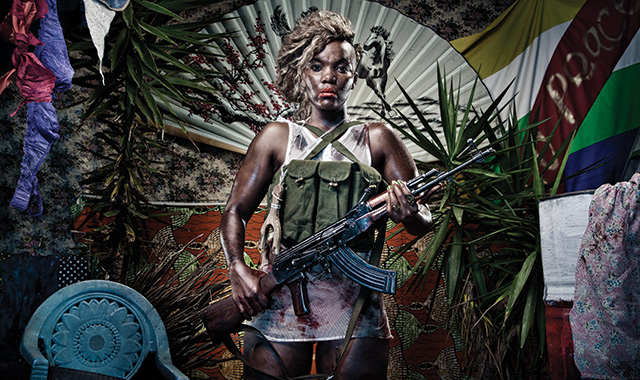
To many outsiders, the South African art world may seem to have produced no more than a few major talents — most notably William Kentridge. Their work further suffers by being narrowly perceived as inextricably associated with apartheid, still the lodestone of South African identity. This oversimplification persists largely because even decades after the global boycott of South Africa’s economy and culture came to an end, the country’s art scene remains small. And while a few galleries are starting to reach out internationally, the arts still lack the broad popular audience at home that they enjoy in the Americas, Europe, and, increasingly, Asia.
Exacerbating the problem, the ruling African National Congress seems more interested in exploiting the divide than in broadening support for the arts, as evidenced by the party’s attempt last year to censor a painting of polygamist president Jacob Zuma as Lenin with his penis exposed. Intended by artist Brett Murray as a denunciation of corruption among ANC leadership, the government moved to suppress the work, launching a lawsuit against Johannesburg’s Goodman Gallery and calling on party members to boycott a newspaper that published the image. A tribunal ruled that no action be taken, but the firestorm left the impression that South Africa’s government was more interested in culture wars than cultural development.
Yet a closer look reveals an art economy beginning to emerge from colonial provincialism. Only a small number of galleries and auction houses thrive in Africa’s largest economy, but top commercial galleries increasingly take part in major art fairs and place work in foreign museum shows, and Goodman, Stevenson, and Everard Read galleries have all recently expanded. Established and newer galleries are supporting a younger generation of contemporary artists, and many nonwhites are gaining the attention of collectors who, until recently, seldom crossed the color barrier. The appreciation and collecting of fine art remain pursuits of the white minority, but a black middle class is beginning to rise. Still, black-owned art businesses and collections can be counted on the fingers of one hand, an unfortunate deficiency in a nation of 52 million inhabitants, 80 percent of whom are black.
Museums, including the major municipal galleries in Johannesburg, Cape Town, Pretoria, and Durban, remain woefully underfunded. Few receive major loans of works from abroad because of financial constraints, substandard facilities, and security issues, and they tend to present mainly regional art and traditional crafts. Private support is negligible owing to unfavorable tax laws that have not fostered a culture of philanthropy. Even the South African National Gallery in Cape Town cannot afford to buy historical or contemporary foreign works, and Riason Naidoo, the institution’s first black director, admits, “We cannot compete with the acquisitions budgets of international museums that are also vying for South African art.” But he notes in what may be a hopeful sign for the emerging scene, “We have been more proactive in identifying talented young artists for our collections who previously would not have been considered.”
FITS AND STARTS
For a brief period in the 1990s South Africa seemed to have become a full-fledged member of the international art circuit. After decades of exclusion during the international economic and cultural boycott that had isolated the country, in 1993 more than 20 South African artists were shown in the Venice Biennale. In 1995 the Ministry of Culture founded the Johannesburg Biennale, which for the first time brought international art to the stigmatized country. The second edition, in 1997, branched out to venues in Cape Town, with shows organized by international curators under the direction of Okwui Enwezor, then a rising curatorial talent. But the event’s major funder, the city of Johannesburg, closed the exhibition early to save money, and the biennial has not been revived since.
Despite rapid social transformation since the fall of apartheid, arts and culture have seldom found a place among government initiatives combating grave socio economic challenges, including rampant poverty and an inadequate education infrastructure. Last fall the national Department of Arts and Culture announced a Visual Arts Task Team to strengthen the arts. Clearly, however, the transformation of South Africa’s art scene will continue to be driven by the private sector. There, growth is the order of the day.
“Government support is low, as is understandable,” says collector Paul Harris, “so in the private sector we try and do as much as we can. Not as in other countries, but you start somewhere.” The former banker was speaking on the terrace of Ellerman House, his cliffside hotel above Cape Town that serves as a showcase for his extensive collection of South African art. On display are classic modernist paintings by Irma Stern and Jacob Hendrik Pierneef, as well as such contemporary works as a slab of polished granite into which conceptualist Willem Boshoff scratched a line for every day Nelson Mandela spent in prison, raunchy political satires by Anton Kannemeyer, a monumental stacked-stone bust by Angus Taylor, and moody figurative paintings by John Meyer.
“There’s a breadth of talent exploring contemporary media across the racial spectrum, and it’s on a par with the rest of the world,” says Fraser Conlon, co-owner of New York’s Amaridian Gallery, which sold sub-Saharan art and design until its recent closure. “The biggest challenge for Africa is access to the global markets. West African artists have a far greater presence because of proximity to Europe, and the colonial background is far more favorable. But southern Africa is more isolated. Only since the dismantling of apartheid have people been willing to consider the country.”
A MODERN RENAISSANCE
Reconsideration of the South African market has been fueled largely by a handful of wealthy collectors within the country and expatriates in England who compete for trophies by such modernists as Maggie Laubser, Pierneef, Alexis Preller, Stern, and Jean Welz. According to the art historian Esmé Berman, in 1993 a post-Impressionist still life by Stern topped R200,000 ($65,000).When it returned to market in 2011, the piece brought more than R10 million ($5 million) at auctioneer Strauss & Co.
Berman says the exponential rise in the early-modern market was catalyzed by Bonhams’ 2007 launch of South African sales in London. The first included 13 Sterns with estimates above £70,000 ($140,000) and one at £550,000 ($1.1 million). Strauss & Co. was founded in 2009 in Johannesburg, and a marketing battle resulted in a string of record prices that culminated in 2011 with the sale of Stern’s Arab Priest, 1945, at Bonhams for £3 million ($5 million) to the Qatar Museums Authority. But by 2012 the auction houses had flooded the market, and the supply of top works had diminished. The annual Bonhams sale last October flopped. The following month, however, in a perverse confirmation of the rising value of works by South African modern masters, paintings by Pierneef, Laubser, Hugo Naudé, and Gerard Sekoto were stolen from the Pretoria Art Museum.
Few contemporary artists achieve such prices, however, without emigrating, as Marlene Dumas and Robin Rhode have done. The South African record for Kentridge, whose 2010 retrospective at the Museum of Modern Art in New York was universally acclaimed, is just R2.2 million ($250,000), set at Stephan Welz in Cape Town in 2010, though one of his works reached $600,000 at Sotheby’s New York in 2011. One of the few other artists of international reputation to make a home in South Africa is photographer Roger Ballen, an American who moved to Johannesburg in 1980. He has documented white poverty in images that mix grim intimacy with touches of Surrealism. He has shown with Gagosian and at major museums, with a 2013 retrospective slated for the Smithsonian’s Museum of African Art in Washington, D.C.
CONTEMPORARY GROWTH
“The scene is changing rapidly,” says Ross Douglas, founding director of the annual Joburg Art Fair, which was launched in March 2008. By the time of the fair’s fifth edition last September, several satellite events and fringe shows had sprung up around town. At the main event, 29 South African, French, German, and British gallery booths were augmented by more than a dozen special projects. But despite high-quality offerings for modest prices, the fair attracted few foreign collectors and curators.
“Part of the fair’s mission is to educate people,” says Douglas. “There are not enough good commercial galleries in South Africa, no government contemporary art museums, no place to look at art. It’s mainly in corporate collections and commercial galleries.”
But according to many arts leaders here, there has been improvement. “The market today is unrecognizable from what it was 10 years ago,” says National Gallery director Naidoo. “It has become more professional; there is more competition with many more commercial galleries, and there are many international museums and collectors acquiring South African modern and contemporary art, which can only be good for the artists. South African commercial galleries are now more visible at international art fairs from Miami to Berlin, and Stevenson for the first time will be participating at Frieze, which is a significant breakthrough.”
Another goal of the Joburg fair is to diversify the audience for contemporary art. “Galleries were perceived to be white, elitist, alienating spaces. We want to change that,” says Douglas, noting that opening night five years ago was an all-white affair. Now affluent blacks number among the patron class, made up largely of bankers, mining barons, winery owners, and corporate executives.
Among the largest collections of modern and contemporary South African art are those of financial institutions and mining companies like absa, BHP Billiton, and Standard Bank. Noted private collectors include the Rupert family in Stellenbosch and Graaff-Reinet; entrepreneur Bruce Campbell-Smith of Cape Town, whose late 19th- and 20thcentury black South African art was shown at the National Gallery in 2005; and investment banker Gordon Schachat, who exhibited parts of his modern and contemporary collection at the Joburg Art Fair in 2009.
Among those in attendance last fall was Kentridge, who feels the fair is a poor substitute for the intellectual heft of a biennial. “I’m very pleased that we have the fair,” he says, “but it’s a shame the biennial no longer exists. That was a curated essay about what’s happening in the art world. The fair, like all fairs, is a trade show.” Nonetheless, the fair provided a snapshot of the variety of young artists from South Africa.
LOOKING BEYOND STRUGGLE
Among the most welcome recent developments in the South African art world was the opening last year of the Wits Art Museum, a modern showcase for tribal and contemporary art in downtown Johannesburg. Then, in December, the country’s first private museum of contemporary art was christened by financier Piet Viljoen in a converted Victorian house in Cape Town. The New Church — named after the street it is on — opened with a show drawn from Viljoen’s 480-piece collection and curated by Stevenson Gallery film artist Penny Siopis, who selected works by Nicholas Hlobo, abstract painter Zander Blom, and installation artists Dineo Seshee Bopape and Wim Botha.
On the international front, South Africa will not only return to Venice in 2013 — the South African Consul General in Milan will serve as Commissioner — but the Department of Arts and Culture has been in discussions to establish a permanent pavilion at the Biennale. As the country’s leadership seeks to transition from revolution to fully functioning democracy, some hope that the character of the art, too, will change. “Art thrives where there’s a lot of turmoil and emotions,” collector Paul Harris observes. “And so for a long time the so-called ‘struggle art’ was the main thing. But my personal view is we’ve got so many more positive things, in terms of building government and reconciliation between people. That will be the future: celebrating what has been achieved in terms of reconciliation, and what still can be.”
To see images, click on the slideshow.
This article appears in the February issue of Art+Auction.
-Author, Jason Edward Kaufman BLOUIN ARTINFO
More of Today’s News from BLOUIN ARTINFO:
Innovators, Part 3: 5 Figures Who Are Redesigning the Way We Experience Art
VIDEO: Painter and Digital Artist Feng Mengbo’s “Not Too Late” in NYC
Tribe of Joe: Saxophonist Joe Lovano and His Us Five Band
Christie’s Increases Buyer’s Premiums Worldwide to Keep “Current With Rising Costs”
Japan’s Yubari Fantastic Film Festival’s Own Story Is Better Than Its Films
Like what you see? Sign up for BLOUIN ARTINFO’s daily newsletter to get the latest on the market, emerging artists, auctions, galleries, museums, and more.
Follow ARTINFO on Twitter: www.twitter.com/artinfodotcom
Rochelle Riley: McDonald’s gives Black History Month salute to budding Detroit-area artists

On the last night of Black History Month in a beautiful little art gallery in the city’s midtown, Jermaine Tripp stood in front of a stunning, pastel drawing of the late U.S. Supreme Court Justice Thurgood Marshall.
The work was done by Tripp, 17, one of a dozen students that a juggernaut company took a minute to celebrate for their art.
Detroit-area McDonald’s restaurant owners gathered at the N’Namdi Center for Contemporary Art to announce the winners of a contest called “McDonald’s Celebrates Black History Moments on Canvas.”
The contest did celebrate famous black people, but what it honored as much as history was talent. It was hard to separate the students’ work from some of the gallery’s other pieces.
The contest’s goal was to encourage southeast Michigan teens to research the proud heritage of local and national African Americans throughout history.
“We are so proud of these young people and their artistic expression of the history, heritage, hard work and accomplishments of black people,” McDonald’s restaurant owner Jon Campbell said as he presented the top awards. “We are thrilled to know that a program about black history resonated with these students and inspired them to use art as a tool for expression and learning”
The group gave cash prizes to all 12 finalists, but the third-place winner received $500; the second place winner rececied $1,000 and Jamaine Tripp?
He got $2,000 and his teacher got $375.
So what’s next for Jermaine Tripp? No, he’s not going to Disney World.
“I want to be an mechanical engineer or an architect,” he said. “I might want to do art on the side.”
By Rochelle Riley
Detroit Free Press
Loïs Mailou Jones: Creating A New African-American Image
For much of the past century of Modern art, African-American artists often looked like outliers. Why did pioneering black painters like Boston-native Loïs Mailou Jones continue to work realistically as the thrust of Western art was toward abstraction?
 Loïs Mailou Jones painting in her Paris studio in
Loïs Mailou Jones painting in her Paris studio in1937 or ’38. (Courtesy of the Museum of Fine Arts, Boston)
“The thing that describes Modernism more than anything else is revolt,” says Edmond Barry Gaither, director of the Museum of the National Center of Afro-American Artists in Boston and a longtime friend of Jones.
While white Modernists were blasting apart the realism pursued in the West since at least the Renaissance, Gaither says, “The radical departure, the revolt of African-American artists at the beginning of the 20th century was the reclamation of African-Americans as human.”
In the face of a Western tradition that portrayed blacks primarily in demeaning racist caricature, if at all, Gaither says, African American art “was involved in reestablishing the validity of a tradition, not involved with smashing one.” Black artists “really took on this role early of creating a new image.”
Loïs Mailou Jones (1905-1998) is the subject of a one-room career survey at Boston’s Museum of Fine Arts (465 Huntington Ave., through Oct. 14) organized by MFA curator Elliot Bostwick Davis. She was born in Boston. Her mother ran a beauty parlor and made hats. Her father was a building superintendent who attended night school to become, at age 40, the first African-Americans to graduate from Suffolk Law School.
“She thought of herself always as a Bostonian,” Gaither says. Long after she moved away, she continued to return to Massachusetts annually, he says, often spending time on Martha’s Vineyard, where, while growing up, her family summered on land her grandmother bought with money she earned as a housekeeper and nanny.
After graduating from the School of the Museum of Fine Arts and the Boston Normal School (now Massachusetts College of Art) in 1927, Jones launched a career in textile design. But driving to Martha’s Vineyard one summer, Jones spotted her designs in the windows of interior-decoration shops, but noted that fabrics bore only the name of the patterns, not her name.
 Loïs Mailou Jones “Negro Student,” 1934, charcoal on paper (Courtesy of the Museum of Fine Arts, Boston)
Loïs Mailou Jones “Negro Student,” 1934, charcoal on paper (Courtesy of the Museum of Fine Arts, Boston)“That bothered me because I was doing all this work but not getting any recognition,” she told a biographer. “And I realized I would have to think seriously about changing my profession if I were to be known by name.”
“She was a very warm person and she was very persistent,” Gaither says. “She made up her mind to work on something and she stuck with it.” Such determination was required to get much of anywhere in the face of huge societal hurdles for women and African-Americans to even enter the art world.
Jones applied to teach at the Museum School, but got the message that her options in the white Boston art world were frustratingly limited when the director told her “go South and help your people.” Still she followed his suggestion, briefly teaching art at Palmer Memorial Institute in North Carolina and then at the legendary black college Howard University in Washington, D.C., from 1930 to 1977.
The 1930s saw her drawing and painting realist portraits of African-Americans and illustrating books. This art, Gaither says, was part of the “New Negro” movement’s effort at creating “sympathetic representations of black American experience and reclamation of African heritage.”
Major shifts in Jones’s style were often precipitated by travels. On a year sabbatical from Howard in 1937, she studied at the Académie Julian in Paris. “It was the first time when she was working in a context where race was going to be irrelevant and she was going to be judged on the merit of her work,” Gaither says.
 Loïs Mailou Jones “My Mother’s Hats,” 1943, oil on canvas. (Courtesy of the Museum of Fine Arts, Boston)
Loïs Mailou Jones “My Mother’s Hats,” 1943, oil on canvas. (Courtesy of the Museum of Fine Arts, Boston)Her 1938 painting “Jeanne, Martiniquais” and her 1943 painting “My Mother’s Hats” show how she pushed her academic realism toward an expressive late Impressionist style—somewhere between Camille Pissarro and the early work of Henri Matisse. This was decades after those styles had been developed and considered radical. “She cast her lot with the conservative style, as many African American artists did, to achieve a certain level of respect,” Gaither says.
In Paris, she met artist Emile Bernard, dancer Josephine Baker, and artist Céline Tabary. And she became acquainted with the international black community via artists from the United States, Africa and the Caribbean. “That also gave her a larger sense of the presence possible for her in the world,” Gaither says.
Back in Washington, she resolved to submit her painting of “Indian Shops, Gay Head, Massachusetts” (not in this show) to the Corcoran Gallery of Art’s annual competition in 1941, even though the museum banned African-American participation. She got around this by having a white friend drop off her painting for her. When her painting won the Robert Woods Bliss Landscape Prize, she preserved her ruse by having the award mailed to her.
 Lois Mailou Jones “Veve Voudou II,” 1963, oil and collage on canvas (Courtesy of the Museum of Fine Arts, Boston)
Lois Mailou Jones “Veve Voudou II,” 1963, oil and collage on canvas (Courtesy of the Museum of Fine Arts, Boston)Jones’s style shifted again after she married Haitian graphic artist Louis Pierre-Noel in 1953 at age 47. They summered in Haiti from 1954 to ’66 where she was wowed by the vitality of Caribbean art. “The art of Africa is lived in the daily life of the people of Haiti,” she said.
In abstractions like her 1963 painting “Veve Voudou II” and her 1985 painting “Glyphs,” she integrates the imagery she soaked up in Haiti with the Abstract Expressionism of artists like Adolph Gottlieb, a New York painter who’d summered in Gloucester and Provincetown, Massachusetts.
With the rise of black political consciousness in the 1960s, as African-Americans fought for civil rights here and blacks in Africa won independence from European colonial rule, Jones’s work became “a celebration of African color and pattern,” Gaither says.
 Loïs Mailou Jones “Ubi Girl from Tai Region,” 1972, acrylic on canvas (Courtesy of the Museum of Fine Arts, Boston)
Loïs Mailou Jones “Ubi Girl from Tai Region,” 1972, acrylic on canvas (Courtesy of the Museum of Fine Arts, Boston)“Loïs’s own temperament was much more interested in the joy of color and design. She’s not really a protest artist,” Gaither says. Her art is about portraying and embracing African-America and its cultural legacy with accuracy and dignity at a time when just portraying African-Americans was radical. Gaither says, “It’s very much in the spirit of black largeness, in a global way.”
In 1970 she made her first trip to Africa, visiting 11 African nations with a grant from Howard University to document artists there. She returned to the continent in 1972, ’76 and ’77.
Inspired by what she saw and merging it with the flat graphics and image sampling of Pop art, she painted works like 1972’s “Ubi Girl from Tai Region.” Jones layers images of an Ubi girl with her face painted with the X design of a fertility ritual, masks from Zaire, a sculptural profile from the Ivory Coast, and African textile patterns.
“She combines [Pop] with source material from Africa, with African design and African pattern, and out of this she synthesizes a new body of work,” Gaither says. Arriving at her late mature style, “she freely draws from all of them to create something that is a consummate expression of the Diaspora.”
 Loïs Mailou Jones “Jeanne, Martiniquaise,” 1938, oil on canvas (Courtesy of the Museum of Fine Arts)
Loïs Mailou Jones “Jeanne, Martiniquaise,” 1938, oil on canvas (Courtesy of the Museum of Fine Arts)Opening! The Kinsey Collection of African American Art and History at MoAD
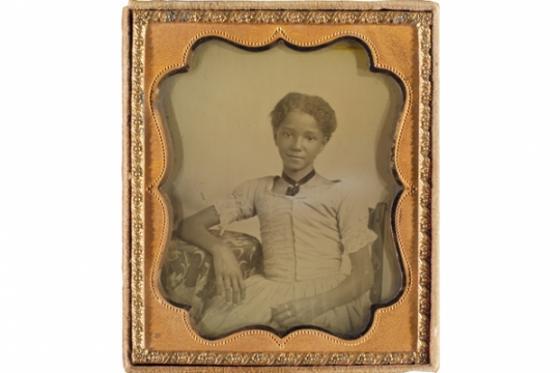
Originally published on CaliforniaHomeDesign.com
Exactly 150 years ago, President Abraham Lincoln signed the Emancipation Proclamation, declaring, “all persons held as slaves” shall be “forever free.” And, the Museum of the African Diaspora is honoring this anniversary with an exhibit of African American art and history from the Kinsey Collection.
More than 100 artifacts, documents, and works of art gathered by Bernard and Shirley Kinsey over the past 35 years are on display through May. The exhibit includes an early copy of the Emancipation Proclamation, letters by Zora Neale Hurston and Malcolm X, and art by masters such as Jacob Lawrence, Gordon Parks, and Alma Thomas.
“We’re not interested in the awful story,” Bernard Kinsey said at a press preview of the show. “We’re interested in all of the people that overcame struggle and we want to celebrate them.”
– See more at: http://www.7×7.com/arts-culture/opening-kinsey-collection-african-american-art-and-history-moad#sthash.95Zy4JXV.dpuf

